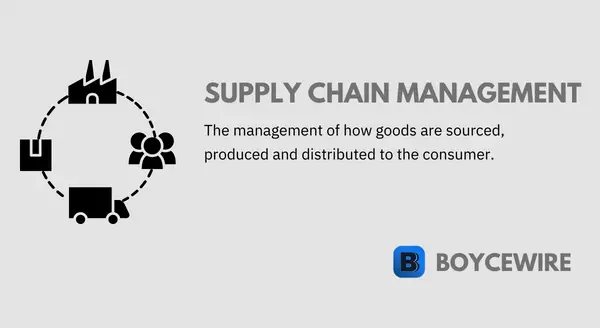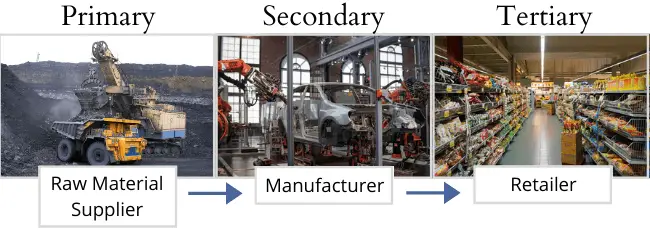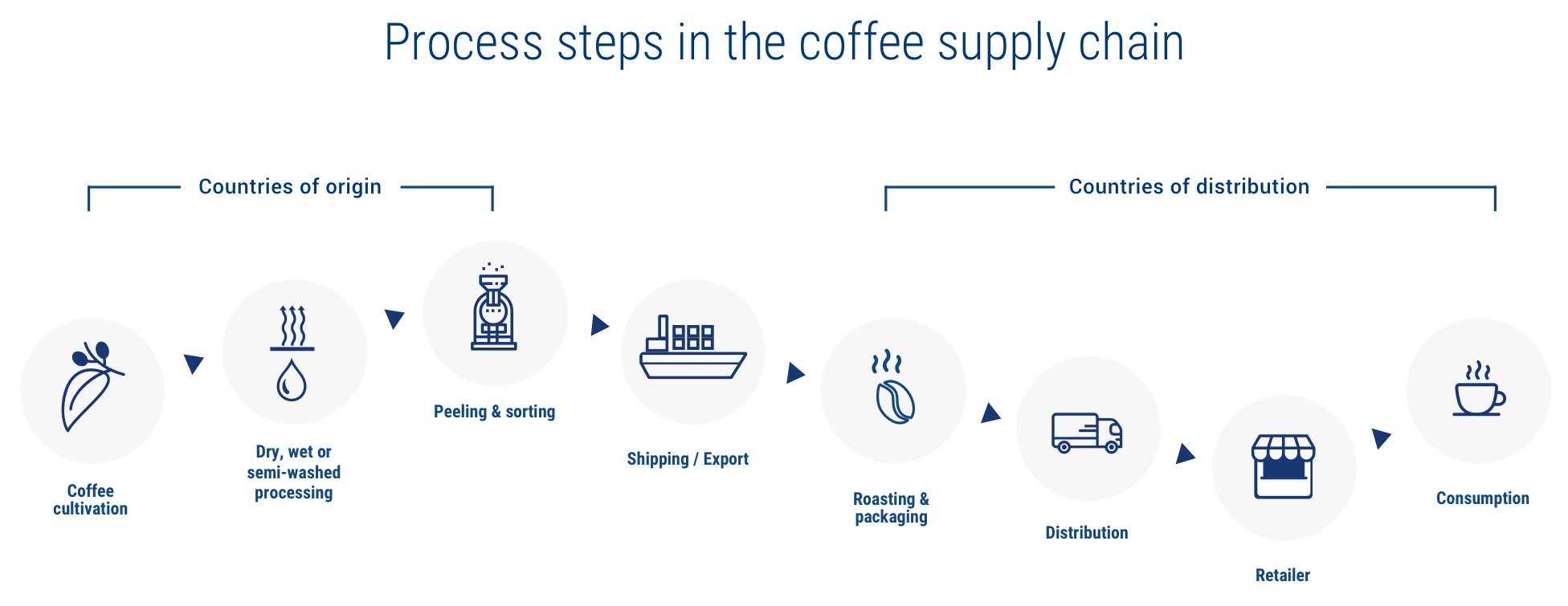Supply Chain Management: Definition, How it Works & Example

What is Supply Chain Management
Supply chain management is the management of goods and services that a business needs to turn raw materials into the final product. This involves managing the raw materials coming into the firm, as well as the distribution of the product being sold by the firm.
Supply chain management is about looking at the intricate details and identifying areas that can go wrong. If we look at a simple supply chain below, there are three stages in the supply chain – the raw material supplier, the manufacturer, and the retailer. This may seem like a simple chain, but there are many components involved. Let us look at them below.

Let us take a simple pencil as an example. The manufacturer has to source the lead for the tip, the wood for the body, rubber for the eraser, and metal to secure it in. These are all raw materials that feed into the supply chain.
In supply chain management, it is necessary to ensure that the continuous supply of these resources is not interrupted. For instance, what if there is a forest fire at one of its wood suppliers? How much of an impact would that have on final distribution?
A delay in the supply of any of these raw materials would represent a breakdown in the supply chain. Specifically, in time-sensitive industries, such as healthcare and hospitality, a supply chain breakdown can be catastrophic. With the case of healthcare – it can cost lives. So supply chain management can be crucially important.
Key Points
- Supply chain management is where businesses look to increase the efficiency and reliability of its supply side activities.
- Every product represents the cumulative effort of multiple companies that collectively make up the supply chain.
How Supply Chain Management Works
Supply chain management comes from the fact that the final good provided is the cumulation of the efforts of everyone along the supply chain. From the miners who extract the raw materials, to the retailer that has it nicely packaged and on view for the final consumer. Supply chain management links these different industries together and seeks to increase the efficiency to reduce costs, reliability, and create a happy consumer.
Supply chain management works by analysing the factors that affect the supply of goods. Are they taking too long to arrive? Are there sunk costs because the goods are getting damaged in transit? Essentially, what is causing the firm to lose money or time during the supply of the goods?
That is the role of the supply chain manager – to see where the company can become more efficient. This is done through six separate components:
Components of Supply Chain Management
1. Planning
Supply chain management involves planning supply, production, demand, as well as sales and operations. So how does it get from the ground to the consumer? With regards to managing supply – it is necessary to ensure that it is optimised to fit alongside demand. For example, a baker doesn’t want to make more bread than he can sell.
We then have production planning which looks at resource allocation such as employees, materials, and equipment. This then feeds into demand planning, which forecasts future demand and how many resources will be needed to meet this.
2. Sourcing
Souring involves finding the right suppliers to provide the inputs needed to produce the final good. Part of this process is identifying and analysing which suppliers would be best from a supply chain point of view. Are they close to the stores? Is the pricing and quality good enough? How reliable are deliveries?
Once such questions are answered and a supplier is chosen, this is monitored by key processes such as ordering management, receiving management, inventory management, and supplier payments. So the supply chain is being constantly monitored by a supply chain manager.
3. Demand/Inventory
Inventory management is crucially important to creating efficiencies with the supply chain. Too few raw materials mean the firm cannot fulfill its customer’s order. Too many raw materials and they may go to waste. If we look at restaurants for instance – they need to order in the perfect amount of supplies. If it doesn’t order enough steaks in, it may lose customers. At the same time, ordering too many may result in the meat going off.
So it’s the role of the supply chain manager to ensure that the inventory supply is optimally aligned with consumer demand. This may involve forecasting demand at certain periods of the day and across the week. In turn, this allows the firm to identify the level of supply that it needs at specific times to fulfill demand.
4. Production
The next stage of supply chain management is ensuring the raw materials are efficiently converted into final goods. It’s one thing to have sufficient raw materials in time, but it’s another to have them ready for the final consumer.
If production of the goods is inefficient, consumers could become dissatisfied by long wait times. For instance, nobody likes to wait 2 hours to get their food at a restaurant. So it’s important for the supply chain manager to ensure the production process flows smoothly.
5. Warehouse & Transportation
Once the firm produces a good, it may need to store in until delivery is made, or, the customer comes to collect. This may require the re-direct of the goods to a specialised storage facility, or simply keeping in on-site, but under specific conditions.
A takeaway pizza may need to be stored in a heated area until the driver comes to collect. A car manufacturer may keep its new cars in a large parking lot at the back of its facilities. The supply chain manager may need to ask questions such as ‘Is there enough space to allow us to produce at X capacity?’, or, ‘Is the product losing quality in its existing storage?’
6. Return of Goods
Not all goods are going to be acceptable to the final consumer. It might be defective, damaged, or simply unwanted. As a result, it needs a channel to facilitate returns.
Long and lengthy return processes can kill off a business – partially those that operate online. So it’s important to ensure a consumer-friendly process, but also one that works for the company. For instance, some goods may need work done to them, whilst others can simply be re-sold. So these would need to go down different supply lines to allocate to the right departments to deal with.
Importance of Supply Chain Management
1. Protects Reputation
The quality of the firm’s supplier reverberates throughout the supply chain. So an issue with a supplier at the start of the chain can end up impacting the delivery of the final product to the consumer. For example, an issue with wheat production may have an impact on the final production of cakes – that rely on flour.
It is important from the firm’s perspective that the chain is efficient and reliable – it doesn’t want customers going unserved and unhappy. That can damage the firm’s reputation if it becomes known as an unreliable supplier either to the consumer or another business.
Once the firm’s reputation is associated with late deliveries or poor-quality products, its brand image will be tarnished – inevitably leading to a loss of business. Nobody wants to go to an unreliable store or supplier.
2. Improve Customer Service
When you go to your favourite restaurant and they don’t have your favourite meal, it is understandable that you will be dissatisfied. Most likely, they have run out of stock – a supply chain management issue. Clearly, not enough stock was ordered to satisfy demand – a mistake made by the demand forecasts. So as a result, there are unhappy customers.
Customers expect to have the product they are looking for in stock – if not, they’ll go elsewhere, which impacts profitability. At the same time, it affects brand image. You don’t want to be the store that is constantly out of stock – nobody wants to shop there!
We also have other factors such as delivery and returns support – other components of supply chain management. If deliveries are late, you have unhappy customers and if it’s a headache to return a faulty product, you equally have an unhappy customer.
By improving supply chain management, a business is able to create happy customers. On-time deliveries, stocked shelves, and easy return policy can make or break some companies.
3. Better Quality of Life
An efficient supply chain means lower costs and lower prices for consumers. In turn, it means the consumer is able to spend more on other goods. For instance, an inefficient agricultural supply chain pushes up the price of food – something everyone needs. If basic necessities are expensive, there is less to spend on other goods such as televisions, laptops, or other consumer goods.
On top of lower prices, an efficient supply chain can reduce environmental impacts such as pollution. For instance, fewer or more efficient deliveries mean fewer cars, lorries, and vans traveling the country emitting carbon emissions. That means cleaner air and a lower impact on the environment.
4. Reduce Costs
An efficient supply chain can help reduce costs in a number of ways. One such is the need for storage. If a retailer orders too many goods – it will increase its inventory costs. By creating an efficient supply so that goods are delivered on time to meet demand, the store is able to avoid costly storage.
By requiring extensive levels of storage, the firm may also face a higher risk of damage to the goods. It might need to go to a storage unit first and then loaded and transported on again. So there is an extra stage of unloading and loading again – not only increasing the risk of damage, but also the need for more staff.
Another aspect of the supply chain that reduces costs is the importance of suppliers to reliably deliver materials on time. For instance, a car manufacturer closing down production for a day can cost it millions.
5. Human Survival
During a crisis situation, having an efficient supply chain is important to saving lives. It might be a hurricane, tsunami, or other natural disasters. Whatever the situation, an efficient supply chain allows the victims to get the water, food, shelter, and other necessities they need.
We also have pandemics – that are a form of a natural disaster, but on a much larger and wider scale. As we saw from the 2020 coronavirus pandemic – the production and supply chain management of ventilators, PPE, and other equipment was crucial to saving many lives. Some countries put in place much more efficient systems than others and subsequently saved more lives.
In addition to a pandemic situation, we have healthcare in general. The supply of blood donations, test results, or organ donations, are all time-sensitive and can potentially save lives. So to ensure an organ donation from North Florida reaches a patient in South Florida, an efficient supply chain needs to be in place. That involves having the correct conditions to allow for it to survive the journey, but also to have transport in place – perhaps a helicopter, airplane, or other vehicles.
6. Improve Cash Flow
Some industries rely on a ‘Just in Time’ system of production whereby the inputs are provided at the last minute. This allows for lower storage costs, but also lower levels of waste – particularly for goods that go bad. In addition to those benefits, the firm only pays for what it needs when it needs it. That means lower cash is being spent on goods that end up stuck in a warehouse.
We also have a need for several factories. If a supply chain can be set up to link to one or two locations, it may save the need to operate from five locations. That means lower costs are being funnelled to the running and maintenance of three additional factories. Instead, those costs can be diverted elsewhere to marketing or lowering the final price to consumers.
Whilst reducing the number of factories can improve cash flow, so too can increasing the speed of delivery. For instance, delivering the final product to the consumer in 2 days instead of 20 means the firm can receive payment much quicker.
Supply Chain Example
Let us take an example of bringing coffee to the consumer. First of all, the coffee farmer has to grow the coffee beans. This involves watering and attending to the crops each day and then harvesting when ready. These are then sold to a processor who then passes these on for peeling and sorting.
Once the coffee beans have been processed, peeled, and sorted, they are then loaded onto shipping containers to be transferred abroad. These are then usually roasted and packaged in the nation it is to be sold in.
Once packaged, a distributor will collect the packaged goods and transfer them to the final retail. There, they are then put out onto the shelves by a store worker, ready for the final consumer to purchase.

Source: Tchibo
Supply Chain Management FAQs
Supply Chain Management is the active monitoring of the businesses process from start to finish. That involves the sourcing of raw materials to delivery of the finished goods to the customer or retailer. For example, Coca Cola would consider the sourcing of its ingredients to the packaging of its bottles and cans, as well as the delivery and distribution to various stores and retailers.
An example of a supply chain can be shown by a simple pencil. First, it requires raw materials such as led, wood, and graphite. These raw materials need to be sourced from various companies whereby another will bring these all together to manufacture it. Once that is complete, the manufacturer then has to package and distribute to the various consumers. This is likely to be traditional retailers such as Walmart, who then sell to the final consumer.
About Paul
Paul Boyce is an economics editor with over 10 years experience in the industry. Currently working as a consultant within the financial services sector, Paul is the CEO and chief editor of BoyceWire. He has written publications for FEE, the Mises Institute, and many others.

Further Reading
 Embezzlement - Embezzlement is the act of fraudulently misappropriating or stealing funds or assets entrusted to one's care, often done by an…
Embezzlement - Embezzlement is the act of fraudulently misappropriating or stealing funds or assets entrusted to one's care, often done by an…  New York City Minimum Wage: The minimum wages impact on jobs - The situation looks dire for full-service restaurant workers. Since the increase to $13, the number of workers declined by over…
New York City Minimum Wage: The minimum wages impact on jobs - The situation looks dire for full-service restaurant workers. Since the increase to $13, the number of workers declined by over…  Intrinsic Value - Intrinsic value refers to the underlying or inherent worth of an asset, based on its fundamental characteristics and cash flow…
Intrinsic Value - Intrinsic value refers to the underlying or inherent worth of an asset, based on its fundamental characteristics and cash flow… 